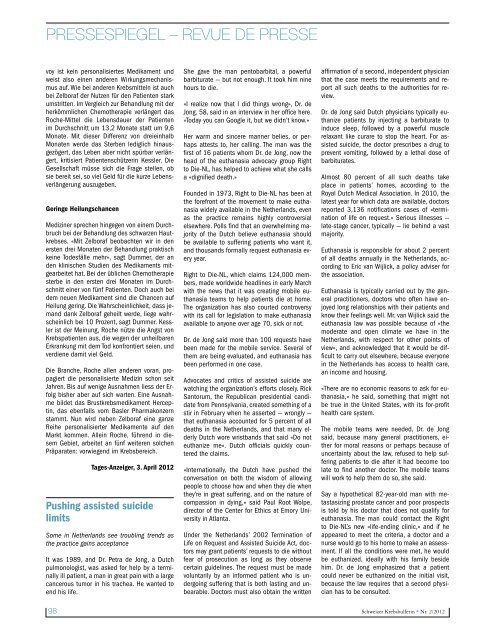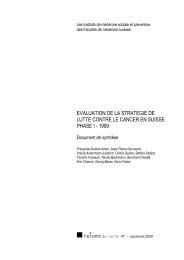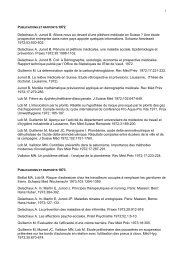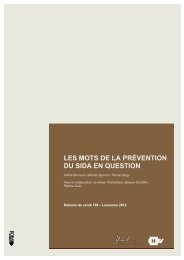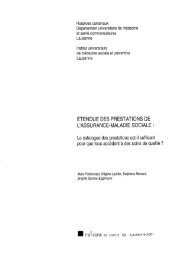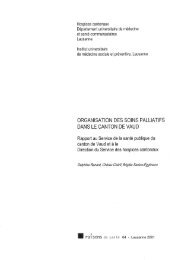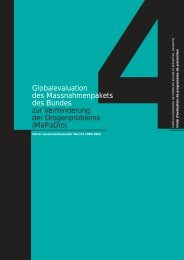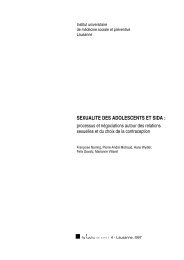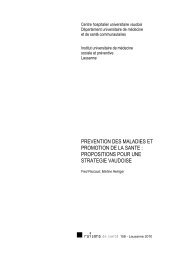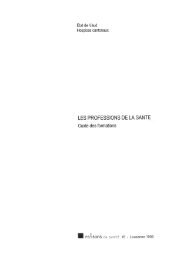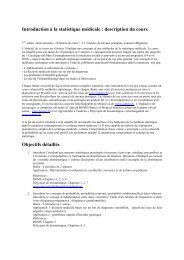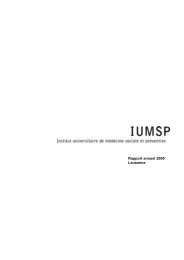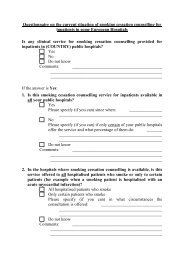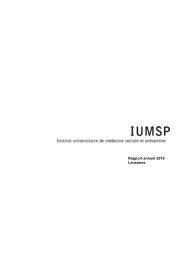Fortbildungen / Formations continues 2012 - IUMSP
Fortbildungen / Formations continues 2012 - IUMSP
Fortbildungen / Formations continues 2012 - IUMSP
Sie wollen auch ein ePaper? Erhöhen Sie die Reichweite Ihrer Titel.
YUMPU macht aus Druck-PDFs automatisch weboptimierte ePaper, die Google liebt.
PRESSESPIEGEL – REVUE DE PRESSE<br />
voy ist kein personalisiertes Medikament und<br />
weist also einen anderen Wirkungsmechanismus<br />
auf. Wie bei anderen Krebsmitteln ist auch<br />
bei Zelboraf der Nutzen für den Patienten stark<br />
umstritten. Im Vergleich zur Behandlung mit der<br />
herkömmlichen Chemotherapie verlängert das<br />
Roche-Mittel die Lebensdauer der Patienten<br />
im Durchschnitt um 13,2 Monate statt um 9,6<br />
Monate. Mit dieser Differenz von dreieinhalb<br />
Monaten werde das Sterben lediglich hinausgezögert,<br />
das Leben aber nicht spürbar verlängert,<br />
kritisiert Patientenschützerin Kessler. Die<br />
Gesellschaft müsse sich die Frage stellen, ob<br />
sie bereit sei, so viel Geld für die kurze Lebensverlängerung<br />
auszugeben.<br />
Geringe Heilungschancen<br />
Mediziner sprechen hingegen von einem Durchbruch<br />
bei der Behandlung des schwarzen Hautkrebses.<br />
«Mit Zelboraf beobachten wir in den<br />
ersten drei Monaten der Behandlung praktisch<br />
keine Todesfälle mehr», sagt Dummer, der an<br />
den klinischen Studien des Medikaments mitgearbeitet<br />
hat. Bei der üblichen Chemotherapie<br />
sterbe in den ersten drei Monaten im Durchschnitt<br />
einer von fünf Patienten. Doch auch bei<br />
dem neuen Medikament sind die Chancen auf<br />
Heilung gering. Die Wahrscheinlichkeit, dass jemand<br />
dank Zelboraf geheilt werde, liege wahrscheinlich<br />
bei 10 Prozent, sagt Dummer. Kessler<br />
ist der Meinung, Roche nütze die Angst von<br />
Krebspatienten aus, die wegen der unheilbaren<br />
Erkrankung mit dem Tod konfrontiert seien, und<br />
verdiene damit viel Geld.<br />
Die Branche, Roche allen anderen voran, propagiert<br />
die personalisierte Medizin schon seit<br />
Jahren. Bis auf wenige Ausnahmen liess der Erfolg<br />
bisher aber auf sich warten. Eine Ausnahme<br />
bildet das Brustkrebsmedikament Herceptin,<br />
das ebenfalls vom Basler Pharmakonzern<br />
stammt. Nun wird neben Zelboraf eine ganze<br />
Reihe personalisierter Medikamente auf den<br />
Markt kommen. Allein Roche, führend in diesem<br />
Gebiet, arbeitet an fünf weiteren solchen<br />
Präparaten: vorwiegend im Krebsbereich.<br />
Tages-Anzeiger, 3. April <strong>2012</strong><br />
Pushing assisted suicide<br />
limits<br />
Some in Netherlands see troubling trends as<br />
the practice gains acceptance<br />
It was 1989, and Dr. Petra de Jong, a Dutch<br />
pulmonologist, was asked for help by a terminally<br />
ill patient, a man in great pain with a large<br />
cancerous tumor in his trachea. He wanted to<br />
end his life.<br />
She gave the man pentobarbital, a powerful<br />
barbiturate — but not enough. It took him nine<br />
hours to die.<br />
«I realize now that I did things wrong», Dr. de<br />
Jong, 58, said in an interview in her of�ce here.<br />
«Today you can Google it, but we didn’t know.»<br />
Her warm and sincere manner belies, or perhaps<br />
attests to, her calling. The man was the<br />
�rst of 16 patients whom Dr. de Jong, now the<br />
head of the euthanasia advocacy group Right<br />
to Die-NL, has helped to achieve what she calls<br />
a «digni�ed death.»<br />
Founded in 1973, Right to Die-NL has been at<br />
the forefront of the movement to make euthanasia<br />
widely available in the Netherlands, even<br />
as the practice remains highly controversial<br />
elsewhere. Polls �nd that an overwhelming majority<br />
of the Dutch believe euthanasia should<br />
be available to suffering patients who want it,<br />
and thousands formally request euthanasia every<br />
year.<br />
Right to Die-NL, which claims 124,000 members,<br />
made worldwide headlines in early March<br />
with the news that it was creating mobile euthanasia<br />
teams to help patients die at home.<br />
The organization has also courted controversy<br />
with its call for legislation to make euthanasia<br />
available to anyone over age 70, sick or not.<br />
Dr. de Jong said more than 100 requests have<br />
been made for the mobile service. Several of<br />
them are being evaluated, and euthanasia has<br />
been performed in one case.<br />
Advocates and critics of assisted suicide are<br />
watching the organization’s efforts closely. Rick<br />
Santorum, the Republican presidential candidate<br />
from Pennsylvania, created something of a<br />
stir in February when he asserted — wrongly —<br />
that euthanasia accounted for 5 percent of all<br />
deaths in the Netherlands, and that many elderly<br />
Dutch wore wristbands that said «Do not<br />
euthanize me». Dutch of�cials quickly countered<br />
the claims.<br />
«Internationally, the Dutch have pushed the<br />
conversation on both the wisdom of allowing<br />
people to choose how and when they die when<br />
they’re in great suffering, and on the nature of<br />
compassion in dying,» said Paul Root Wolpe,<br />
director of the Center for Ethics at Emory University<br />
in Atlanta.<br />
Under the Netherlands’ 2002 Termination of<br />
Life on Request and Assisted Suicide Act, doctors<br />
may grant patients’ requests to die without<br />
fear of prosecution as long as they observe<br />
certain guidelines. The request must be made<br />
voluntarily by an informed patient who is undergoing<br />
suffering that is both lasting and unbearable.<br />
Doctors must also obtain the written<br />
af�rmation of a second, independent physician<br />
that the case meets the requirements and report<br />
all such deaths to the authorities for review.<br />
Dr. de Jong said Dutch physicians typically euthanize<br />
patients by injecting a barbiturate to<br />
induce sleep, followed by a powerful muscle<br />
relaxant like curare to stop the heart. For assisted<br />
suicide, the doctor prescribes a drug to<br />
prevent vomiting, followed by a lethal dose of<br />
barbiturates.<br />
Almost 80 percent of all such deaths take<br />
place in patients’ homes, according to the<br />
Royal Dutch Medical Association. In 2010, the<br />
latest year for which data are available, doctors<br />
reported 3,136 noti�cations cases of «termination<br />
of life on request.» Serious illnesses —<br />
late-stage cancer, typically — lie behind a vast<br />
majority.<br />
Euthanasia is responsible for about 2 percent<br />
of all deaths annually in the Netherlands, according<br />
to Eric van Wijlick, a policy adviser for<br />
the association.<br />
Euthanasia is typically carried out by the general<br />
practitioners, doctors who often have enjoyed<br />
long relationships with their patients and<br />
know their feelings well. Mr. van Wijlick said the<br />
euthanasia law was possible because of «the<br />
moderate and open climate we have in the<br />
Netherlands, with respect for other points of<br />
view», and acknowledged that it would be dif-<br />
�cult to carry out elsewhere, because everyone<br />
in the Netherlands has access to health care,<br />
an income and housing.<br />
«There are no economic reasons to ask for euthanasia,»<br />
he said, something that might not<br />
be true in the United States, with its for-pro�t<br />
health care system.<br />
The mobile teams were needed, Dr. de Jong<br />
said, because many general practitioners, either<br />
for moral reasons or perhaps because of<br />
uncertainty about the law, refused to help suffering<br />
patients to die after it had become too<br />
late to �nd another doctor. The mobile teams<br />
will work to help them do so, she said.<br />
Say a hypothetical 82-year-old man with metastasizing<br />
prostate cancer and poor prospects<br />
is told by his doctor that does not qualify for<br />
euthanasia. The man could contact the Right<br />
to Die-NL’s new «life-ending clinic,» and if he<br />
appeared to meet the criteria, a doctor and a<br />
nurse would go to his home to make an assessment.<br />
If all the conditions were met, he would<br />
be euthanized, ideally with his family beside<br />
him. Dr. de Jong emphasized that a patient<br />
could never be euthanized on the initial visit,<br />
because the law requires that a second physician<br />
has to be consulted.<br />
98 Schweizer Krebsbulletin � Nr. 2/<strong>2012</strong>


